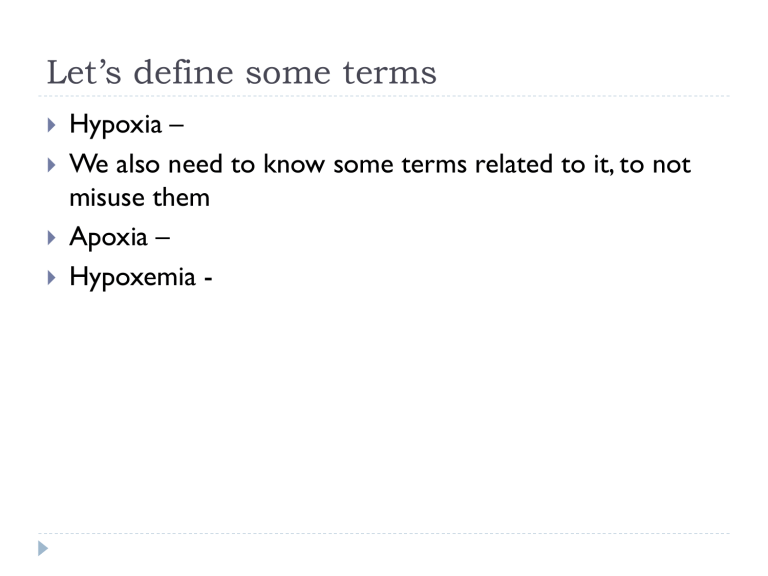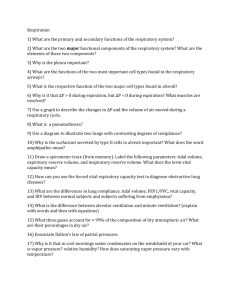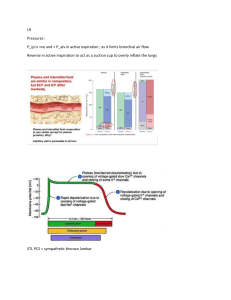
Let’s define some terms Hypoxia – We also need to know some terms related to it, to not misuse them Apoxia – Hypoxemia - Early signs (catch them and prevent brain damage or damage to the heart) Restlessness - is a complete state of mental health and can be encountered as an inability to relax, remain at rest, concentrate, or have a constant feeling of uneasiness Anxiety Tachycardia – heart rate is more than 100 beats per minute Tachypnea - accelerated breathing - is a respiratory rate greater than normal, resulting in abnormally rapid and shallow breathing. (above than respiratory rate of 12–20 per minute) (Hyperventilation – excessive increase in pulmonary ventilation that exceeds the metabolic demands of the body so it can change the blood chemistry. it can lead to respiratory alkalosis (elevation of blood pH) (Hypertonia – an increase in the depth in the respiration rate, does not change the blood chemistry) Late signs late signs Bradycardia – decreased heart rate, lower than 60 beats per minute Extreme restlessness Dyspnea – shortness of breath Cyanosis (alert the patient and take care of him as quickly as possible!) – bluish cast of skin types exogenous endogenous hypoxemic Ischemic Anemic Histotoxic Hypoxemic hypoxia asthma Ischemic 1) cause: decrease of partial pressure of O2 within of alveoli (see hypoxemia) OR the exchange membrane was thickened→ impede the gas exchange following: the exchange of gases isn’t occurring efficiently p(O2) in blood going to lungs = 40mmHg → capillary blood → gas exchange: O2 moves down the concentration gradient from alveoli to blood (vessel) until the p in the pulmonary capillary blood equals the p in the alveoli (60mmHg as example) → normal p(O2) in blood going from lungs = 100mmHg 2) atherosclerotic plaques OR thrombus accumulation in one area → plaque, occlusion to blood vessel → very little blood is getting by in this area → very little red blood cells in capillary → Hb carries 4O2 → decrease of O2 delivery to tissues 3) congestive heart failure (сердечная недостаточность) (a chronic condition in which the heart progressively becomes weaker and less efficient at pumping blood around the body.) → decrease of cardiac output (heart rate * stroke volume) (norm 5 liters per minute) → decrease of O2-rich blood volume delivery (supply) to tissues Anemic 1) very little red blood cells being produced → aplastic anemia (is a rare bone marrow failure disorder in which the bone marrow stops making enough blood cells ); or hemolytic anemia (occurs when red blood cells are broken up in the bloodstream or in the spleen. Hemolytic anemia may be due to mechanical causes (leaky heart valves or aneurysms), infections, autoimmune disorders, or congenital abnormalities in the red blood cell.) 2) deficient or abnormal hemoglobin due to: microcytic anemia iron deficiency B12 deficiency folic acid deficiency thalascenia sicklecenia Red blood cells carry hemoglobin, an iron-rich protein that attaches to O2 in the lungs and carries it to tissues throughout the body. 1 red blood cell = 250 million Hb molecules = 1 billion O2 molecules 1 Hb molecule can bind 4 O2 molecules → so abnormal Hb can significantly affect the amount of O2 molecules that are being bound hypoxia, in biology and medicine, condition of the body in which the tissues are starved of oxygen. In its extreme form, where oxygen is entirely absent, the condition is called anoxia. Four types of hypoxia are distinguished in medicine: (1) the hypoxemic type, in which the oxygen pressure in the blood going to the tissues is too low to saturate the hemoglobin; (2) the anemic type, in which the amount of functional hemoglobin is too small, and hence the capacity of the blood to carry oxygen is too low; (3) the stagnant type, in which the blood is or may be normal but the flow of blood to the tissues is reduced or unevenly distributed; (4) (4) the histotoxic type, in which the tissue cells are poisoned and are therefore unable to make proper use of oxygen. Diseases of the blood, the heart and circulation, and the lungs may all produce some form of hypoxia. hypoxemic The hypoxemic type of hypoxia is due to one of two mechanisms: (1) a decrease in the amount of breathable oxygen—often encountered in pilots, mountain climbers, and people living at high altitudes—due to reduced barometric pressure (see altitude sickness) (2) (2) cardiopulmonary failure in which the lungs are unable to efficiently transfer oxygen from the alveoli to the blood. anemic In the case of anemic hypoxia, either the total amount of hemoglobin is too small to supply the body’s oxygen needs, as in anemia or after severe bleeding, or hemoglobin that is present is rendered nonfunctional. Examples of the latter case are carbon monoxide poisoning and acquired methemoglobinemia, in both of which the hemoglobin is so altered by toxic agents that it becomes unavailable for oxygen transport, and thus of no respiratory value. stagnant Stagnant hypoxia, in which blood flow through the capillaries is insufficient to supply the tissues, may be general or local. If general, it may result from heart disease that impairs the circulation, impairment of veinous return of blood, or trauma that induces shock. Local stagnant hypoxia may be due to any condition that reduces or prevents the circulation of the blood in any area of the body. Examples include Raynaud syndrome and Buerger disease, which restrict circulation in the extremities; the application of a tourniquet to control bleeding; ergot poisoning; exposure to cold; and overwhelming systemic infection with shock. histotoxic In histotoxic hypoxia the cells of the body are unable to use the oxygen, although the amount in the blood may be normal and under normal tension. Although characteristically produced by cyanide, any agent that decreases cellular respiration may cause it. Some of these agents are narcotics, alcohol, formaldehyde, acetone, and certain anesthetic agents.



